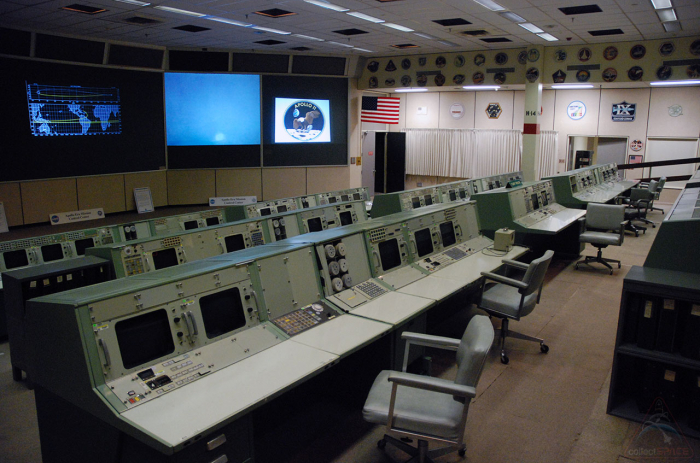Only the slightly battered sign screwed to the government-issue grey paint gives you a clue to its historical significance.
The sign lists 42 missions, covering more than a quarter of a century. They range from Gemini 4 in 1965 – with America’s first spacewalk – through the Apollo missions to the Moon, to the early Space Shuttle flights.
Some of the most dramatic moments in modern human history, including the first Moon landing, the rescue of Apollo 13, and the Challenger disaster, have been overseen from this room.
“The place had a feel to it, kind of like putting on a well-fitting glove,” says Gerry Griffin, a flight director on the Apollo missions. “When I go back into it now, it’s a little more like a cathedral – a place of almost reverence.”
Go through the door and it’s clear that this cathedral has seen better days. Although Mocr-2 has been preserved as a National Historic Landmark, since it was last used for operations in the early 1990s the room’s condition has deteriorated. So much so, that it was recently designated as “threatened.” The iconic control consoles were getting damaged and the room was becoming faded and shabby.

The room will be restored to its original condition, looking like it would during the days of the space race (Credit: Richard Hollingham)
Now, ahead of the 50th anniversary of the first Moon landing in July, Nasa is working to restore Apollo mission control to its former glory. At this stage of the conservation project, however, Mocr-2 is looking worse than ever.
The screens are blank, ceiling tiles are missing, the walls are stripped bare, and the carpet is stained and tattered. Numbered Post-it stickers cover surfaces where items have been removed. The chairs and some of the iconic consoles have been taken away for restoration, while others are covered in protective plastic sheeting.
Nevertheless, there’s still something very special about this room. “Even now when it’s all stripped down and there’s nothing, not even a flag, you know it’s different,” says Nasa historic preservation officer Sandra Tetley. “You can tell history was made here, you just feel it.”
They’ll be lights blinking, clocks working, projections on the screens, they’ll be things placed on the consoles – manuals, coffee and cigarette butts in the ashtrays – Sandra Tetley
Tetley is overseeing the restoration project that, with only six months to go, still has a very long to-do list. Restoration, rather than refurbishment – “I hate the word,” says Tetley – is the name of the game.
“The idea is that when you step into the viewing room at the back, you’ll be stepping back in time and it’ll look like the flight controllers have just stepped away from their consoles,” she explains. “They’ll be lights blinking, clocks working, projections on the screens, they’ll be things placed on the consoles – manuals, coffee and cigarette butts in the ashtrays.”
In the high stakes, high stress environment of 1960s mission control, coffee and cigarettes played a major role. “Everybody smoked, everybody drank coffee,” says Griffin. “You could see the smoke in the room – and the smell had to be just horrendous, with smoke and a bunch of bodies, but we didn’t notice because we’d been in it all day.”

Sandra Tetley is overseeing the restoration of the room in time for the Moon landing’s 50th anniversary (Credit: Richard Hollingham)
Preserving some of that atmosphere is one of the goals of the restoration. “The original ceiling was white but over the years with cigarette tar it’s yellowed,” says Tetley. “We’re leaving all that grime so you can still see that yellowish colour.”
The walls too will be restored with their original pattern. “In the plans we weren’t going to have wallpaper but then we found a fragment of original paper behind a fire extinguisher,” she says. “We were able to go back to the manufacturer and they found the actual roller that made the wallpaper, so we’ve been able to recreate it.”
It’s a similar story with the carpet, with fragments of the original recovered from beneath the consoles. Another re-discovery when they removed the consoles was a system of pneumatic tubes. Mission controllers used these to send canisters containing messages to and from their support teams dotted around the Houston complex.
As part of the restoration, and complete overhaul with modern electronics, these screens, and the clocks above them, will once again come to life
“They would send notes back and forth, and flight controllers said that one of the really interesting things in this room was to hear that noise – it was shuum, shuum with these pneumatic tubes going,” says Tetley. “They no longer work but controllers say that some of the things they put through these tubes included hot dogs and mice!”
Considering the high drama that unfolded in this room, it’s perhaps appropriate that the design of Mocr-2 is almost like a theatre, with a viewing gallery at the rear and then a rack of consoles overlooking floor to ceiling screens. The video and data displayed here was back-projected from a concealed and windowless room behind the screen known as the “Bat Cave”.

The room was where Mission Control members helped guide the crew of Apollo 13 back to safety (Credit: Nasa)
As part of the restoration, and complete overhaul with modern electronics, these screens, and the clocks above them, will once again come to life. And another room, to the right of the screens is also being rebuilt. This was the Simulation Control Room, where a training team could simulate problems that might occur during missions.
“The simulation people gave us errors to see how we’d handle them,” says Griffin. “They’d give us an error and we’d handle it, then another, then another, so eventually they’d bring us to our knees and we would get kind of frustrated.”
Following restoration, all the consoles will be off-limits with strict restrictions on access to help preserve room Mocr-2 for all mankind well into the future
“There was a door in the very back corner [of the simulation room] and we’re putting that door back,” adds Tetley. “They called it the simulation supervisor escape door – because emotions used to get so raised between the flight controllers and simulators, that he could dart out of the back door and escape.”
Even in the recent past, visitors to the floor of mission control have been able to sit in the seats and play at being flight director (I confess that in a previous visit a few years ago, I have done this). Following restoration, all the consoles will be off-limits with strict restrictions on access to help preserve room Mocr-2 for all humankind well into the future. Instead, visitors will see the room through the glass of the VIP viewing gallery at the back, as if they were watching a real mission unfolding.
Once complete, and as part of the celebrations of the first Moon landing, the final people who will get to sit at the consoles will be the original mission controllers. Photos will be taken of them sitting at their work stations to create a lasting record of their contribution to human spaceflight.
Tetley says it’s always a joy to see them back in the room where they made history.
“They’re like kids in a candy store,” says Tetley. “They’re just smiling, remembering what they did here – it’s very moving for me to see them and their appreciation for what we’re doing.”
BBC Future
More about: Space
















































